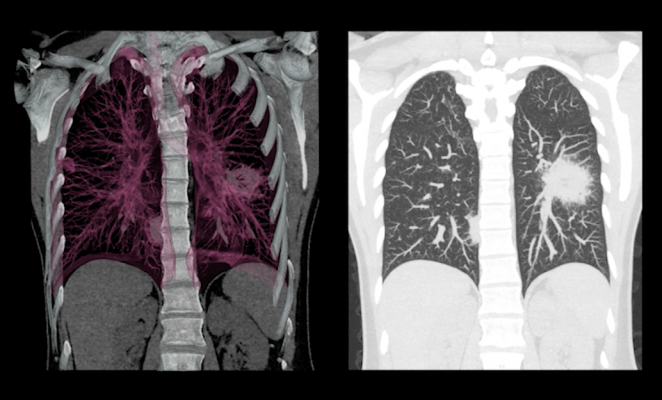
Image courtesy of Toshiba/Canon
December 8, 2020 — For heavy (ex-)smokers, lung cancer screening using low-dose computed tomography (low-dose CT, LDCT) offers more benefit than harm. The procedure can save a number of people from dying of lung cancer; for some of them, it might also prolong overall survival. This is the conclusion drawn by IQWiG in its final report commissioned by the Federal Joint Committee (G-BA).
Overall, the IQWiG project team sees a hint of a benefit of low-dose CT for lung cancer screening versus no screening for the outcome "mortality". This benefit is accompanied by harm from false-positive screening results and overdiagnosis. For the high-risk group of heavy (ex-)smokers, however, the benefit outweighs the potential harm.
Low-dose CT for lung cancer screening under evaluation
Lung cancer is one of the leading causes of cancer deaths worldwide. Men are diagnosed at a median age of 70, women at 69. Lung cancer is usually discovered at a late stage, so that five years after diagnosis, only one fifth to one sixth of people affected are still alive.
At present, there is no systematic screening for lung cancer in Germany and LDCT is not part of the scope of services provided by statutory health insurance. Pursuant to the Radiation Protection Act, the Federal Ministry for the Environment, Nature Conservation and Nuclear Safety (BMU) is currently evaluating whether radiation exposure due to several years of LDCT screening (including follow-up diagnostics) is permissible.
Low-dose CT screening reduces lung cancer mortality
The results of eight randomized controlled trials (RCTs) with more than 90,000 people provide an indication of a benefit of LDCT screening for heavy (ex-)smokers: Within about ten years, it can prevent about 5 out of every 1,000 people from dying of lung cancer.
In contrast, no statistical advantage of LDCT screening is shown for all-cause mortality. This could be because people saved from death by lung cancer die from other tobacco-related diseases instead, such as other types of cancer or cardiovascular diseases. However, the results of meta-analyses of all pooled study data suggest a reduction in all-cause mortality.
In the overall weighing of disease-specific mortality and all-cause mortality, in its final report IQWiG therefore concludes that there is a hint of a benefit of low-dose CT for lung cancer screening versus no screening.
Misdiagnosis and overdiagnosis are rather rare
A false-positive result alone means harm to the people affected. The diagnosis of lung cancer also requires histological or cytological confirmation, which - like any diagnostic procedure and treatment - carries the risk of side effects and complications. For instance, surgical interventions are performed without a lung tumour always being present, sometimes with serious side effects. However, the risk of harm in the studies included varies: 1 to 15 out of every 1000 people underwent unnecessary surgery due to false-positive screening results.
Overdiagnosis detects lung tumours that would never have been noticed without screening and would never have required treatment. The risk of being overdiagnosed also varies greatly in the studies analysed: Out of every 1000 people invited to screening, 0 to 22 might be affected by an overdiagnosis. The risk of overdiagnosis for people diagnosed with lung cancer during the screening phase ranged between 0 and 63 percent in the studies. This highlights the importance of an optimized screening strategy to keep the risk of overdiagnosis low.
For the high-risk group of heavy (ex-)smokers, however, the benefit outweighs these aspects of harm. In summary, there is a hint of a benefit of low-dose CT screening versus no screening.
Screening strategy is important
An optimal screening strategy is the basis for a positive benefit-harm ratio of low-dose CT for lung cancer screening. For this purpose, the high-risk population to be examined must be defined as precisely as possible by means of smoking behaviour and remaining life expectancy. As in the studies analysed, lung cancer screening should be supported in practice by specific quality assurance measures (diagnostic algorithm, types of devices, follow-up, etc.).
Further optimization of low-dose CT for lung cancer screening is currently ongoing. For example, up to the end of 2024, a European study is investigating the safety of risk-based examination intervals and strategies for implementation: The EU project "4-IN THE LUNG RUN", in which German research institutions are also involved, is to include a total of 24,000 people in an RCT.
For more information: www.


 May 02, 2024
May 02, 2024 








